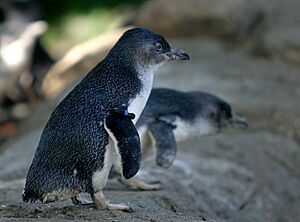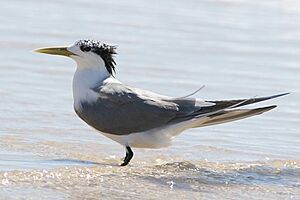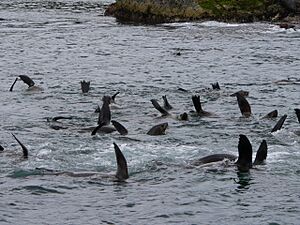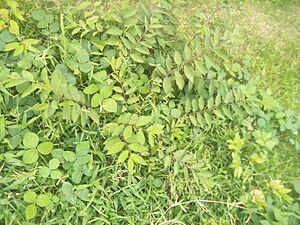Montague Island (Australia) facts for kids
|
Native name:
Barunguba
|
|
|---|---|
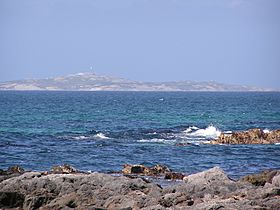
The island viewed from Narooma, 9 kilometres (5.6 mi) away
|
|
| Geography | |
| Location | Tasman Sea |
| Administration | |
|
Australia
|
|
| State | New South Wales |
| Montague Island Nature Reserve New South Wales |
|
|---|---|
|
IUCN Category IV (Habitat/Species Management Area)
|
|

Australian fur seals located in the water adjacent to the island
|
|
| Nearest town or city | Narooma |
| Established | January 1990 |
| Area | 0.81 km2 (0.3 sq mi) |
| Visitation | 6,000 (in 2002) |
| Managing authorities | NSW National Parks & Wildlife Service |
| Website | Montague Island Nature Reserve |
| See also | Protected areas of New South Wales |
Montague Island is a special island off the South Coast of New South Wales, Australia. It is part of the Montague Island Nature Reserve. This reserve helps protect the island's amazing nature. The island is about 9 kilometres (5.6 mi) from the town of Narooma.
Montague Island is the second biggest island off the New South Wales east coast. Only Lord Howe Island is larger. The island is very important for its beautiful views, science, and history. The National Trust has called it a special "Landscape Conservation Area". The buildings of the Montague Island Light are also famous for their design.
Europeans first saw the island in 1770. This was during James Cook's voyage. He first thought it was part of the mainland. Later, a ship captain named it after George Montagu-Dunk. This was in 1790.
Today, Montague Island is a popular place to visit. People come to see its lighthouse and wildlife. It is especially known for its little penguins. The NSW National Parks & Wildlife Service (NPWS) looks after the island. You can only visit the island on guided tours. These tours are run by the NPWS and other companies.
Contents
Montague Island Lighthouse
A lighthouse stands tall on Montague Island. The Australian Maritime Safety Authority takes care of it. This lighthouse helps guide ships safely. It was designed by James Barnet and built in 1881.
The lighthouse became automatic in 1986. This means no one needed to live there anymore. The last lighthouse keepers left in 1987. The lighthouse is 21 metres (69 ft) tall. Its light shines from 80 metres (260 ft) above the sea. It can be seen from far away. The original special lens was moved in 1986. You can now see it at the Narooma Lighthouse Museum.
Amazing Wildlife on Montague Island
Montague Island is home to many different animals. The New South Wales National Parks and Wildlife Service has recorded 49 types of animals there. It is a safe place for them to live.
Little Penguins: Island Residents
The island has a very large group of little penguins. They are also called fairy penguins. There are no foxes or wild cats on the island. This means the penguins are safe from these animals. Their only natural enemies are some seabirds and seals.
The number of penguins has grown a lot. This is because their natural homes have been fixed. Also, special nesting boxes have been added for them. Now, about 12,000 penguins live on the island. Female penguins usually lay two eggs. If the year is good, both baby chicks will survive. The penguins come ashore at sunset after hunting for food in the sea. Visitors can watch them from a special viewing platform.
Crested Terns: White Birds of the Sea
Crested terns are another bird found here. They have bright white feathers on their bodies. Their heads are completely black. You can often see them flying around the island.
Shearwaters: Mutton Birds of the Island
Shearwaters, also known as mutton birds, also nest on the island. These birds spend most of their lives at sea. They come to the island to lay their eggs and raise their young. Some types of shearwaters found here are:
- Puffinus bulleri (Buller's shearwater)
- Puffinus griseus (sooty shearwater)
- Puffinus pacificus (wedge-tailed shearwater)
- Puffinus tenuirostris (short-tailed shearwater)
Seals: Island Visitors
The northern part of Montague Island is a seasonal home for seals. Many male seals gather here. It is hard for visitors to reach this area by land. So, people usually see them from a boat.
Most of the seals are Australian fur seals. Other types have also been seen. These include New Zealand fur seals, subantarctic fur seals, and Australian sea lions. They come to the island to rest and socialize.
Climate on Montague Island
| Climate data for Montague Island | |||||||||||||
|---|---|---|---|---|---|---|---|---|---|---|---|---|---|
| Month | Jan | Feb | Mar | Apr | May | Jun | Jul | Aug | Sep | Oct | Nov | Dec | Year |
| Record high °C (°F) | 41.0 (105.8) |
37.2 (99.0) |
33.8 (92.8) |
29.1 (84.4) |
26.9 (80.4) |
22.0 (71.6) |
24.0 (75.2) |
25.9 (78.6) |
31.7 (89.1) |
34.1 (93.4) |
34.9 (94.8) |
37.2 (99.0) |
41.0 (105.8) |
| Mean daily maximum °C (°F) | 23.0 (73.4) |
23.3 (73.9) |
22.4 (72.3) |
20.5 (68.9) |
18.2 (64.8) |
16.2 (61.2) |
15.5 (59.9) |
16.1 (61.0) |
17.5 (63.5) |
18.8 (65.8) |
20.0 (68.0) |
21.7 (71.1) |
19.4 (66.9) |
| Mean daily minimum °C (°F) | 17.4 (63.3) |
17.9 (64.2) |
17.1 (62.8) |
15.2 (59.4) |
13.2 (55.8) |
11.1 (52.0) |
10.0 (50.0) |
10.2 (50.4) |
11.3 (52.3) |
12.7 (54.9) |
14.2 (57.6) |
16.0 (60.8) |
13.9 (57.0) |
| Record low °C (°F) | 9.5 (49.1) |
5.9 (42.6) |
9.6 (49.3) |
6.9 (44.4) |
5.7 (42.3) |
3.1 (37.6) |
2.1 (35.8) |
2.2 (36.0) |
4.5 (40.1) |
6.9 (44.4) |
6.7 (44.1) |
8.7 (47.7) |
2.1 (35.8) |
| Average precipitation mm (inches) | 71.1 (2.80) |
83.5 (3.29) |
100.3 (3.95) |
81.4 (3.20) |
74.3 (2.93) |
96.7 (3.81) |
51.6 (2.03) |
53.7 (2.11) |
57.4 (2.26) |
63.0 (2.48) |
76.1 (3.00) |
65.4 (2.57) |
881.8 (34.72) |
| Average precipitation days | 10.5 | 10.3 | 10.9 | 8.8 | 8.5 | 8.8 | 6.9 | 8.0 | 8.8 | 10.2 | 12.1 | 11.0 | 114.8 |
| Source: Bureau of Meteorology | |||||||||||||
The climate on Montague Island is generally mild. It has warm summers and cool winters. The island gets a good amount of rain throughout the year. This helps the plants and animals thrive.
Protecting the Island: Environmental Restoration
One big problem on the island is a plant called Kikuyu grass. It is a type of weed. It was brought to the island a long time ago. It was used to feed animals kept by the lighthouse keepers. But it spread and now covers much of the southern part of the island.
This grass makes it hard for native plants to grow. It also creates a thick barrier. This barrier makes it difficult for shearwaters and penguins to move around or dig their burrows. To control it, NPWS workers use special methods. They treat a section of the grass, then burn it. After that, volunteers help plant native plants. In areas that are harder to reach, they spray the kikuyu grass from the air. This helps protect the breeding spots for shearwaters.



